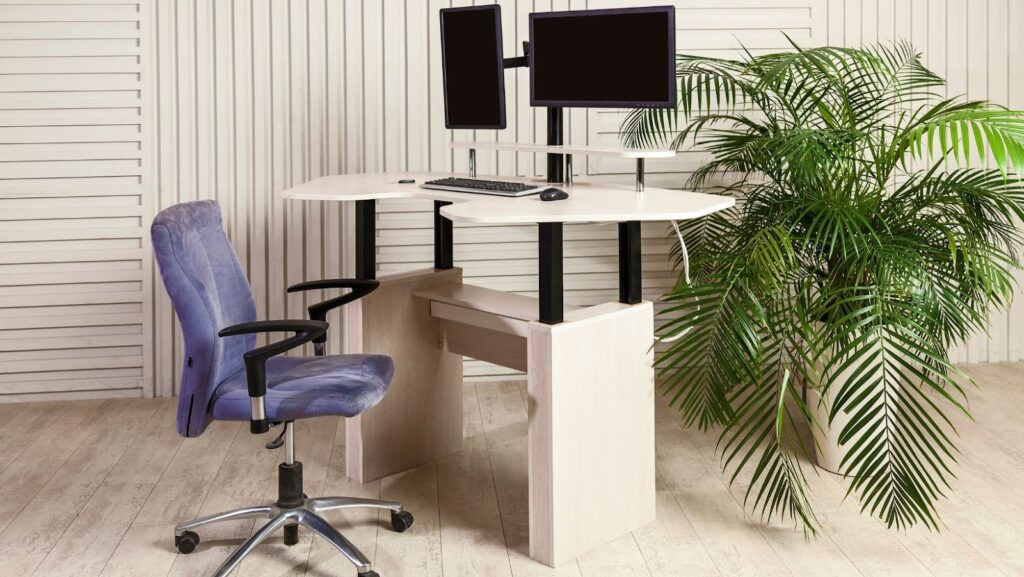
Meta-Title: Improve your workspace with a standing desk and experience the ergonomic and health benefits. Explore solutions for a productive and comfortable work environment.
Do you spend most of your workday glued to an office chair, hunching over a keyboard? Millions of Americans face the health consequences of prolonged sitting, from back pain and fatigue to an increased risk of chronic diseases. But what if there is a solution named “a standing desk” that can revolutionize your workday and improve your overall well-being?
Ergonomics is the science of designing workplaces to fit the human body. It plays a crucial role in preventing work-related musculoskeletal disorders (WMSDs). By optimizing the layout and furniture in your workspace, it aims to reduce discomfort, fatigue, and the risk of injuries. A standing desk is a key ergonomic tool, promoting healthy posture and movement throughout the workday.
Risks of Prolonged Sitting
The human body was not designed to sit for extended periods. Research has linked prolonged sitting to a multitude of health problems, including:
Musculoskeletal issues. Sitting strains your back, neck, and shoulders, leading to pain and discomfort.
Increased risk of chronic diseases. Studies suggest a connection between prolonged sitting and a higher risk of obesity, type 2 diabetes, and heart disease.
Reduced energy levels. Sitting for extended periods can lead to fatigue and decreased productivity.
Benefits of Alternating Between Sitting and Standing
The human body thrives on movement. Alternating between sitting and upright position throughout the workday offers several advantages:
Improved posture. Vertical body position encourages better spinal alignment, reducing strain on your back and neck.
Increased blood flow. It improves circulation, leading to higher energy levels and better focus.
Reduced risk of health problems. Alternating between sit-stand positions mitigates the risks associated with prolonged sitting.
Ergonomic and Health Benefits of Using a Standing Desk
Sit-stand desks promote a more ergonomic workspace, impacting your health and well-being. Here are some key benefits:
Improved Posture and Reduced Risk of Musculoskeletal Issues
Being upright straightens your spine and reduces slouching, alleviating pressure on your back and neck. It reduces the risk of pain and discomfort associated with prolonged sitting.
Increased Energy Levels and Productivity
Studies have shown that convertible workstations can lead to increased energy levels and improved cognitive function.

Upright positions boost blood flow, which can enhance focus and reduce fatigue, promoting higher productivity throughout the workday.
Potential Weight Management Benefits
Upright position burns more calories than sitting, potentially aiding in weight management efforts. While not a magic bullet for weight loss, incorporating a standing desk into your routine can contribute to a healthier lifestyle.
Additional Ergonomic Benefits
Standing desks encourage subtle micro-movements throughout the day, which helps strengthen core muscles and improve overall balance.
Types of Sit-Stand Desks
Choosing a modern workstation for your needs is essential. Here are two main types available:
Traditional Desk Converters
These are stand-alone desks that can be manually or electronically adjusted to different heights. They offer a workspace designed for standing work.
Sit-Stand Solutions
These are more compact and budget-friendly options. They sit on top of your existing desk and can be adjusted to a standing height, creating a dedicated standing workstation.
Considerations When Choosing a Height-Adjustable Workstation
To ensure you select the ideal standing desk for your needs, consider the following factors:
Height adjustability. Ensure the desk adjusts to a height that promotes proper posture with your elbows at a 90-degree angle.
Weight capacity. Choose a desk that can accommodate your weight and the equipment you plan to use.
Features. Consider features like built-in drawers for storage, a keyboard tray for ergonomic typing, or a dual monitor arm for added workspace convenience. Standing desk converters with a dual monitor arm setup can be particularly useful for those who require a multi-screen workspace.
Setting Up Your Standing Desk Correctly
Getting the most out of your standing desk requires proper setup and workstation arrangement. Here are some key points to consider:
Proper Desk Height and Monitor Placement
The key to reaping the ergonomic benefits of a height-adjustable desk lies in proper setup. Your monitor should be positioned at eye level when standing, promoting a neutral neck and head posture.

Ergonomic desks range in height from 22″ to 50″. Use an adjustable desk height calculator online or experiment to find the height that allows your elbows to bend at a comfortable 90-degree angle while standing.
Ergonomic Accessories for Height-Adjustable Workstations
Even with a properly adjusted workstation, incorporating ergonomic accessories can further enhance your comfort and well-being. Here are some key additions:
Anti-fatigue mat. Standing for extended periods can put a strain on your legs and feet. An anti-fatigue mat provides a cushioned surface that promotes subtle movement and improves circulation.
Footrest. A footrest offers a place to rest your feet comfortably while standing and can help reduce lower back strain.
Wrist rest. A wrist rest supports and reduces pressure on your wrists while typing or using a mouse.
Lumbar support pillow. For additional back support, consider using a lumbar support pillow that fits the curve of your lower back in your chair when transitioning to sitting.
Tips for Transitioning to a Standing Desk Routine
Here are some additional tips to ensure a smooth transition to your standing desk routine:
Start slowly. Start in upright position for short periods throughout the day and gradually increase the duration as your body adjusts.
Alternate. Don’t feel pressured to stand all day. Aim for a balance throughout the workday. A common approach is to alternate between 30-minute intervals of sitting and standing.
Listen to your body. Pay attention to any discomfort and adjust your posture, and desk height, or take breaks as needed.
Stay hydrated. Being upright can increase dehydration. So, be sure to drink plenty of water throughout the day.
Invest in comfortable footwear. Wearing supportive shoes with good arch support can make a big difference in your standing comfort.
Remember, the key to maximizing your standing desk experience is proper setup, incorporating ergonomic accessories, and gradually transitioning to a standing routine that works best for you. With little planning and the right tools, your standing desk can become a cornerstone of a healthier, more productive workday.






